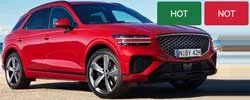I really don't think so. They do use some BMW components, like the drivetrain, but the rest of the vehicle is pretty much a RR design and the assembly is pretty much handmade. From what I read, the new SUV is an all-aluminum substructure that is used in an existing RR sedan, which is probably the biggest factor in speed to market.
Bingo!
The Cullinan rides on RR's
Architecture of Luxury platform which was first used on the Phantom VIII and will be used on other RR models down the road.
They had a platform in place, Genesis did not.
In fact, RR is beating its parent, BMW to the large CUV game; the X7 won't hit the lots til late this year or maybe not even until early 2019 - which, btw is when the GV80 is due to be launched (in Korea).
Don't know why there is a need to constantly harp on this - we all know that the Genesis CUVs are coming and that they are on the time-table that they are on due to time-frame of developing the next gen Genesis platform.
BMW waited on a full-size CUV until it had developed the new (lighter-weight) CLAR platform which underpins the 7 Series (and will underpin pretty much every BMW model going forward).
The current Genesis RWD platform is heavy, so using it to underpin CUVs would have caused a weight problem even greater than what Genesis has already experienced for its sedans.
Genesis was not going to develop its CUVs on Hyundai's old FWD drive platforms (which underpin the Santa Fe Sport, Tucson, etc.) and even if they had opted to go w/ the cheaper FWD option, they would have waited until the newer platform(s) which underpins the new Santa Fe, the upcoming
Palisade and the next gen Tucson.
Which would have meant that a Genesis CUV based on the new Santa Fe platform probably wouldn't have launched yet in Korea (the Santa Fe gets priority) and at best would probably have seen a release some time later this year - so all in all, wouldn't have made that much of a difference in terms of getting to market.
This isn't just about Genesis vs RR. RR is probably the last (or close to last) luxury or super-luxury brand to bring a SUV to market, except of course Genesis which appears to be dead last.
Genesis still hasn't launched the G70 here yet (which is another matter), but Canada just got it.
An automaker doesn't want all its product launches to be bunched together as it causes problems when the models hit the end of their respective life-cycles.
Let's just hope Genesis keeps to its timeline and launches the GV80 next year.
Timely is not being dead last. Making automobile is a business, and it is competitive, and the performance of management is made in comparson to the competition, not what Hyundai management decides in their own mind.
For 2017, Hyundai (not counting Kia) sold about 4.5 million vehicles, but they missed their own goals of selling over 5 million.
And much of missing that sales target for 2017 was due to China where Hyundai sales were pummeled due to the boycott over the dispute over THAAD.
There is a time-line for developing new platforms and rationale behind the choices that are made.
For instance, Hyundai didn't engineer the 1G Genesis platform w/ AWD capability (even tho they knew that AWD was important for the NA market) b/c they wanted to keep things simpler for their first run thru (knowing that couldn't totally mess up when it came to reliability).
People constantly gnashing about the lack of AWD availability wasn't going to make it happen faster - AWD was only going to be available w/ the 2G Genesis/G80 platform.
That 2G platform isn't really suitable for CUV duty due to its weight - which is why Genesis CUVs will be underpinned by the lighter weight next gen platform (which is being developed within the normal time-frame of engineering new platforms).
Yeah, one could say that Hyundai should have engineered the 2G platform to be lighter from the start, but maybe Hyundai didn't have the engineering expertise and/or were willing to eschew doing such a thing due to cost and its ramifications (automakers like
Cadillac and Jaguar had to scrimp on their interiors due to so much of their R&D investment going into their lightweight platforms).









